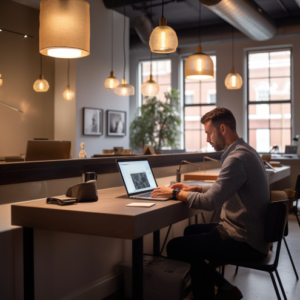Want to learn about the importance of website performance monitoring? A website’s performance is a crucial aspect of user experience, and monitoring it is an essential part of website maintenance. As website owners, it’s our responsibility to ensure that our website is performing optimally. In this article, we’ll discuss the importance of website performance monitoring and provide actionable tips on how to monitor and improve your website’s performance.
Why Website Performance Monitoring is Important?
Website performance monitoring is crucial for several reasons:
User Experience
A slow-loading website can negatively impact the user experience, leading to increased bounce rates and decreased user engagement. With attention spans decreasing every year, it’s crucial to ensure that your website loads quickly and smoothly to keep users engaged.
Search Engine Optimization
Website speed is a crucial factor in search engine rankings. Google’s algorithm takes into account website speed and performance when ranking websites. A slow website can hurt your search engine rankings and decrease your visibility on search engines.
Business Impact
Poor website performance can lead to lost revenue and a damaged reputation. A website that is slow or unresponsive can deter potential customers from making a purchase or taking a desired action on your website.
Benefits of Website Performance Monitoring
Website performance monitoring provides several benefits, including:
Early Detection of Issues
Website performance monitoring allows you to identify issues before they impact users. By monitoring key metrics, you can quickly detect and resolve issues, reducing downtime and improving user experience.
Performance Optimization
Monitoring website performance allows you to optimize your website for speed and user experience continually. By identifying and fixing issues, you can improve website speed, resulting in a better user experience and improved search engine rankings.
How to Monitor Website Performance
There are several ways to monitor website performance, including:
Using a Website Monitoring Service
A website monitoring service is a third-party service that monitors your website’s performance and alerts you when issues arise. These services typically monitor several key metrics, including uptime, load time, and page speed.
Manual Monitoring
Manual monitoring involves regularly checking your website’s performance by testing it on various devices and networks. This method can be time-consuming but allows for more in-depth analysis of your website’s performance.
Tools for Monitoring Website Performance
There are several tools available to help you monitor website performance, including:
Google Analytics
Google Analytics is a free tool that provides detailed website performance metrics, including page views, bounce rates, and load times. It also allows you to set up custom alerts to notify you of performance issues.
Pingdom
Pingdom is a website monitoring tool that monitors your website’s uptime, load time, and page speed. It also provides detailed reports and alerts you of performance issues.
GTmetrix
GTmetrix is a tool that analyzes your website’s performance and provides detailed reports on how to improve it. It also provides recommendations on how to optimize your website for better performance.
Key Metrics to Monitor
When monitoring website performance, it’s essential to track several key metrics, including:
Page Load Time
Page load time is the time it takes for a website page to fully load. It’s crucial to monitor this metric, as a slow page load time can negatively impact the user experience and search engine rankings.
Uptime
Uptime is the percentage of time your website is available and accessible to users. It’s essential to monitor uptime to ensure that your website is available to users when they need it.
Page Speed
Page speed measures how quickly your website pages load. It’s an essential metric to track, as a slow page speed can negatively impact the user experience and search engine rankings.
Best Practices for Website Performance Monitoring
When monitoring website performance, there are several best practices to follow:
Regular Monitoring
Regularly monitoring your website’s performance allows you to detect issues before they impact users. It’s recommended to monitor your website’s performance at least once a week.
Set up Alerts
Setting up alerts allows you to quickly detect and respond to performance issues. It’s recommended to set up alerts for key metrics, such as page load time and uptime.
Use Multiple Tools
Using multiple monitoring tools allows you to get a more comprehensive view of your website’s performance. It’s recommended to use at least two monitoring tools to ensure that you’re getting accurate and complete data.
Common Causes of Poor Website Performance
Several factors can contribute to poor website performance, including:
Large File Sizes
Large file sizes, such as images and videos, can slow down website load times. It’s recommended to optimize file sizes to improve website performance.
Server Issues
Server issues, such as slow response times or downtime, can negatively impact website performance. It’s recommended to use a reliable hosting provider to minimize server issues.
Poor Code
Poorly written code can slow down website load times and lead to performance issues. It’s recommended to use clean, optimized code to improve website performance.
Ways to Improve Website Performance
There are several ways to improve website performance, including:
Optimizing Images
Optimizing images by reducing file size and using the correct file format can improve website performance.
Using a Content Delivery Network
A content delivery network (CDN) can improve website performance by delivering website content from the closest server to the user, reducing load times.
Caching
Caching allows website content to be stored on the user’s device, reducing the need to download content each time a user visits the website. This can significantly improve website performance.
Conclusion
Website performance monitoring is essential for ensuring a positive user experience and maintaining search engine rankings. By monitoring key metrics and following best practices, you can improve website performance and avoid performance issues.
FAQs
Q1. What is website performance monitoring?
Website performance monitoring is the process of regularly checking and tracking key metrics related to a website’s performance, such as page load time, uptime, and page speed.
Q2. Why is website performance monitoring important?
Website performance monitoring is essential for ensuring a positive user experience, maintaining search engine rankings, and avoiding lost revenue and a damaged reputation due to poor performance.
Q3. What are some tools for monitoring website performance?
Some tools for monitoring website performance include Google Analytics, Pingdom, and GTmetrix.
Q4. What are some common causes of poor website performance?
Common causes of poor website performance include large file sizes, server issues, and poor code.
Q5. How can I improve website performance?
There are several ways to improve website performance, including optimizing images, using a content delivery network, and implementing caching.





